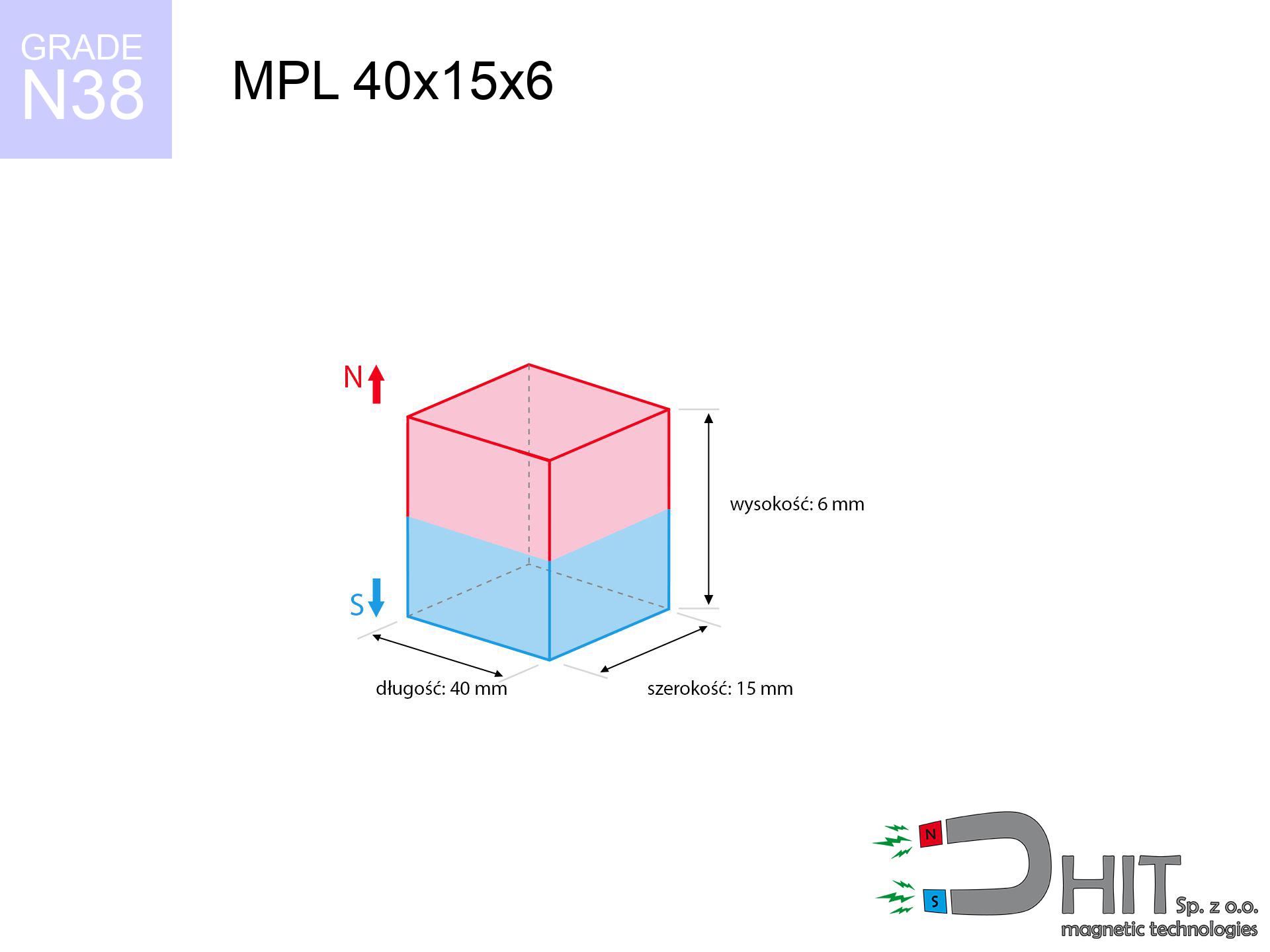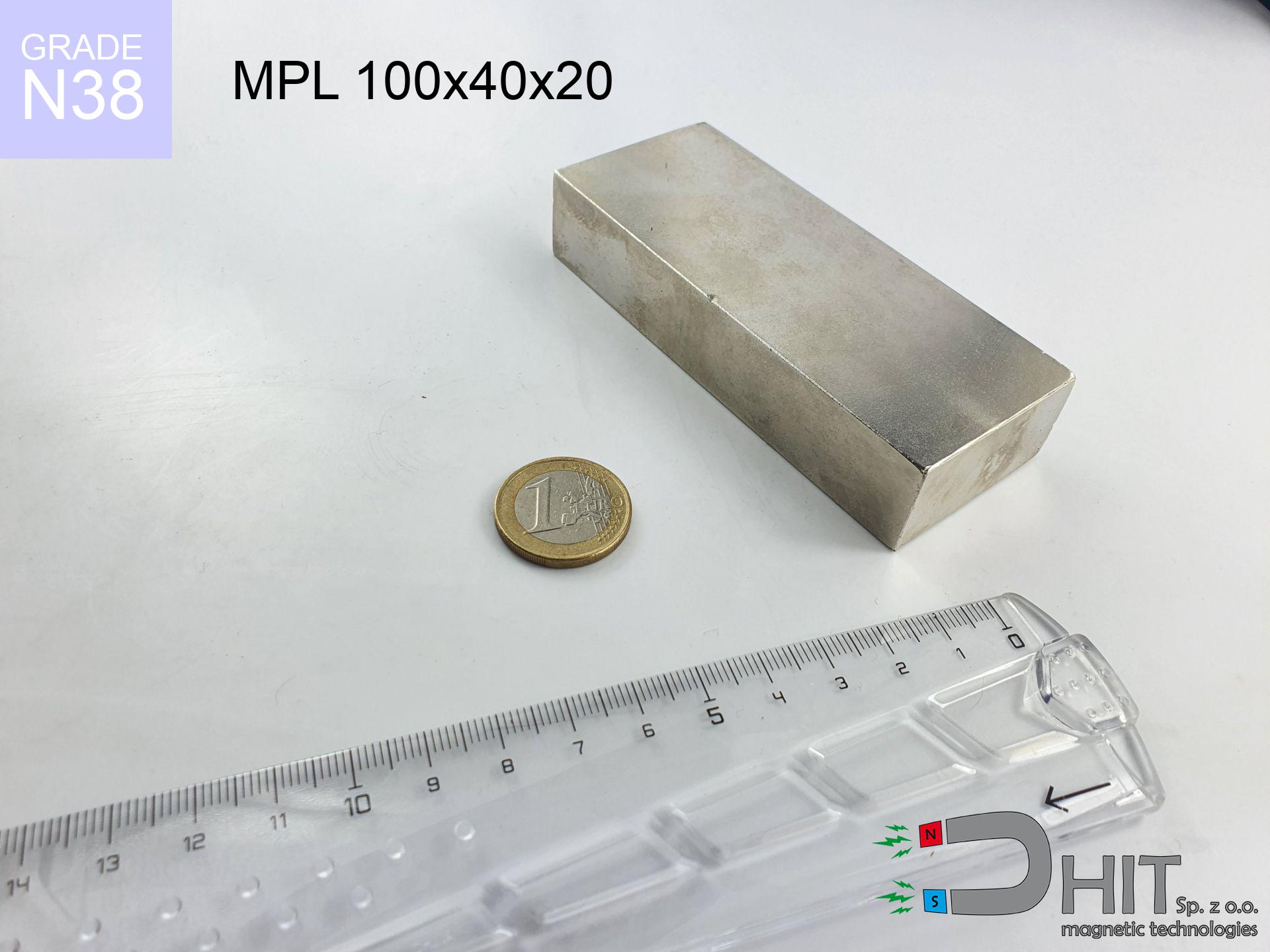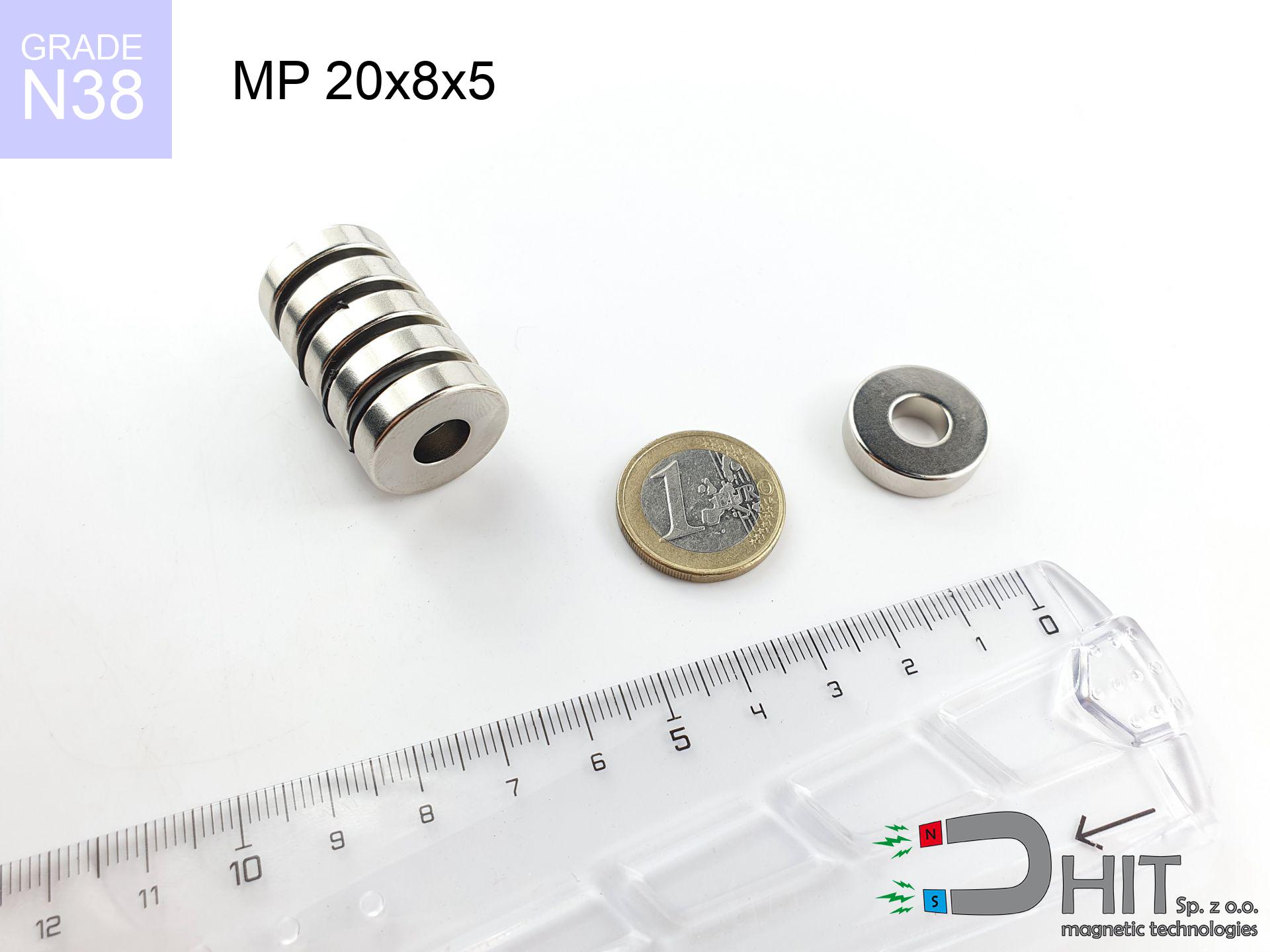MPL 40x15x6 / N38 - lamellar magnet
lamellar magnet
Catalog no 020155
GTIN: 5906301811619
length
40 mm [±0,1 mm]
Width
15 mm [±0,1 mm]
Height
6 mm [±0,1 mm]
Weight
27 g
Magnetization Direction
↑ axial
Load capacity
11.61 kg / 113.86 N
Magnetic Induction
286.36 mT
Coating
[NiCuNi] nickel
18.45 ZŁ with VAT / pcs + price for transport
15.00 ZŁ net + 23% VAT / pcs
bulk discounts:
Need more?Can't decide what to choose?
Contact us by phone
+48 22 499 98 98
otherwise get in touch via
inquiry form
the contact form page.
Force along with structure of magnetic components can be analyzed on our
magnetic calculator.
Orders placed before 14:00 will be shipped the same business day.
Magnetic properties of material N38
Physical properties of sintered neodymium magnets Nd2Fe14B at 20°C
Shopping tips
Strengths as well as weaknesses of rare earth magnets.
Besides their stability, neodymium magnets are valued for these benefits:
- They retain magnetic properties for almost ten years – the drop is just ~1% (according to analyses),
- Neodymium magnets are distinguished by exceptionally resistant to loss of magnetic properties caused by external field sources,
- The use of an shiny finish of noble metals (nickel, gold, silver) causes the element to be more visually attractive,
- Magnetic induction on the top side of the magnet is very high,
- Made from properly selected components, these magnets show impressive resistance to high heat, enabling them to function (depending on their form) at temperatures up to 230°C and above...
- Thanks to the option of precise molding and adaptation to specialized needs, NdFeB magnets can be created in a wide range of forms and dimensions, which increases their versatility,
- Fundamental importance in future technologies – they serve a role in magnetic memories, drive modules, medical devices, also technologically advanced constructions.
- Compactness – despite small sizes they provide effective action, making them ideal for precision applications
Disadvantages of NdFeB magnets:
- Brittleness is one of their disadvantages. Upon intense impact they can fracture. We recommend keeping them in a strong case, which not only protects them against impacts but also raises their durability
- NdFeB magnets lose force when exposed to high temperatures. After reaching 80°C, many of them experience permanent drop of power (a factor is the shape as well as dimensions of the magnet). We offer magnets specially adapted to work at temperatures up to 230°C marked [AH], which are very resistant to heat
- Magnets exposed to a humid environment can corrode. Therefore during using outdoors, we advise using water-impermeable magnets made of rubber, plastic or other material resistant to moisture
- Limited ability of producing threads in the magnet and complex shapes - recommended is a housing - magnet mounting.
- Potential hazard related to microscopic parts of magnets can be dangerous, in case of ingestion, which becomes key in the aspect of protecting the youngest. Additionally, small elements of these devices are able to complicate diagnosis medical after entering the body.
- Higher cost of purchase is a significant factor to consider compared to ceramic magnets, especially in budget applications
Maximum lifting capacity of the magnet – what affects it?
Breakaway force was defined for optimal configuration, taking into account:
- with the use of a yoke made of low-carbon steel, guaranteeing maximum field concentration
- possessing a thickness of minimum 10 mm to avoid saturation
- with an ground touching surface
- with direct contact (no impurities)
- for force acting at a right angle (pull-off, not shear)
- at temperature approx. 20 degrees Celsius
Impact of factors on magnetic holding capacity in practice
Please note that the application force may be lower depending on elements below, in order of importance:
- Clearance – existence of any layer (paint, tape, air) interrupts the magnetic circuit, which lowers power steeply (even by 50% at 0.5 mm).
- Load vector – highest force is obtained only during perpendicular pulling. The shear force of the magnet along the surface is standardly many times lower (approx. 1/5 of the lifting capacity).
- Wall thickness – thin material does not allow full use of the magnet. Part of the magnetic field passes through the material instead of converting into lifting capacity.
- Material composition – different alloys attracts identically. Alloy additives worsen the interaction with the magnet.
- Plate texture – smooth surfaces guarantee perfect abutment, which increases force. Rough surfaces reduce efficiency.
- Thermal environment – temperature increase causes a temporary drop of induction. It is worth remembering the thermal limit for a given model.
* Lifting capacity was measured using a polished steel plate of optimal thickness (min. 20 mm), under vertically applied force, whereas under shearing force the holding force is lower. Additionally, even a minimal clearance {between} the magnet and the plate lowers the load capacity.
H&S for magnets
Heat sensitivity
Regular neodymium magnets (grade N) lose power when the temperature goes above 80°C. This process is irreversible.
Allergic reactions
Medical facts indicate that the nickel plating (the usual finish) is a potent allergen. For allergy sufferers, avoid touching magnets with bare hands or select encased magnets.
Adults only
Product intended for adults. Tiny parts pose a choking risk, leading to serious injuries. Keep out of reach of kids and pets.
Warning for heart patients
Individuals with a ICD must keep an absolute distance from magnets. The magnetism can stop the functioning of the implant.
Serious injuries
Risk of injury: The pulling power is so immense that it can result in blood blisters, pinching, and even bone fractures. Use thick gloves.
Handling rules
Use magnets with awareness. Their immense force can shock even experienced users. Be vigilant and do not underestimate their force.
Fire warning
Fire warning: Rare earth powder is highly flammable. Avoid machining magnets without safety gear as this risks ignition.
Data carriers
Do not bring magnets close to a purse, laptop, or TV. The magnetic field can destroy these devices and wipe information from cards.
Magnetic interference
Note: rare earth magnets generate a field that interferes with sensitive sensors. Maintain a safe distance from your mobile, device, and navigation systems.
Magnets are brittle
Despite metallic appearance, the material is brittle and not impact-resistant. Avoid impacts, as the magnet may crumble into hazardous fragments.
Safety First!
Details about risks in the article: Safety of working with magnets.





![SM 32x350 [2xM8] / N42 - magnetic separator SM 32x350 [2xM8] / N42 - magnetic separator](https://cdn3.dhit.pl/graphics/products/sm-32x350-2xm8-nih.jpg)



